Expanding Quillard's Oeuvre
© Martin Eidelberg
Created March 2022; revised April 2022
© Martin Eidelberg
Created March 2022; revised April 2022
 |
| 1. Pierre Antoine Quillard, La Fête du mai, oil on canvas, 54.2 x 45.2 cm. Paris, Musée du Louvre. |
A century ago, in the 1920s and ‘30s, attributions to Pierre Antoine Quillard (c. 1704-1733) were hotly debated. The discussion had been precipitated by the Musée du Louvre’s purchase in 1927 of a pair of fête galantes, La Fête du mai and La Danse villageoise (fig. 1). These works had appeared at a London auction two years earlier, where they were ascribed to Watteau and it was under his name that they entered the Louvre. But their authenticity was soon questioned and Quillard was proposed as the true author. This created a great uproar, and incensed articles about the attribution and Quillard’s artistic identity appeared in the Parisian press and international art magazines. There was even a court trial in which the Louvre successfully sued for a refund of part of the purchase price. All this was only the first chapter in a longer and wider brouhaha. Similar paintings were brought forth from disparate locations—France, Portugal, Russia, and Italy—and were given to Quillard. Although not without strenuous dissension, there gradually emerged a consensus regarding his oeuvre. Whereas previously his name had been essentially unknown, it now was well established. Not least of all, he had become an artist with a substantial oeuvre.
Although a great more paintings were ascribed to Quillard in subsequent decades, they mostly prove to be by anonymous artists working in the wake of Watteau. Like the master’s other satellites, Jean-Baptiste Pater and Nicolas Lancret, Quillard unfortunately became a catch basin for anonymous eighteenth-century fêtes galantes. Like Pirandello’s six characters in search of an author, these paintings were homeless. Rather than focusing on those undeserving works, I propose returning to the central core of Quillard’s oeuvre. This essay brings together eleven paintings that have not been identified with Quillard before or have not been presented publicly. Their stylistic coherence reinforces our understanding of his distinctive manner and, moreover, these works shed light on his studio practice and the way that he often painted several versions of a single composition.
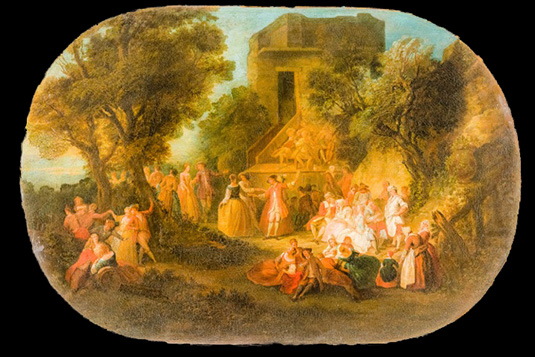 |
| 2. Pierre Antoine Quillard, Festivities Outside a Country Inn, oil on canvas, 53 x 79 cm. Whereabouts unknown. |
The first picture to be considered is Festivities Outside a Country Inn (fig. 2). It appeared twice in German auctions about a decade ago, both times attributed to Jean-Baptiste Pater.1 However, it clearly is unrelated to Pater but, rather, is unmistakably executed in Quillard’s style. The dancers at the far left and at center–-with their slender bodies and turned heads—are wholly characteristic of his work.
Moreover, this fête galante is almost the twin of two other versions of this composition, one in Dublin (fig. 3) and another, a slightly larger variation equivalent in size to our German example, that was on the Paris market in 1950 (fig. 4).2 Person for person, tree for tree, the three compositions are essentially the same. As will be seen, Quillard seems to have delighted in replicating his compositions. Whereas the Dublin and Paris paintings are rectangular in format, our new painting is a horizontal oval, a shape rarely employed by Watteau or his immediate followers. Yet Quillard employed it on other occasions, as in a pair of oval pendants that until recently remained with dukes of Cadaval, important patrons of his in the later part of his career (fig. 12).
My colleague David Pullins kindly pointed out to me that the Museum of Fine Arts in Budapest owns a painting by Quillard, a scene of amorous pilgrims arriving at the island of Cythera (fig. 5).3 In the past the picture was probably attributed to Watteau, but by the mid-twentieth century when it entered the museum’s collection, it was ascribed to a German eighteenth-century master working under the influence of French art. In 1991 Quillard’s authorship was correctly recognized on the basis of analogous compositions by him that I had previously published, specifically a painting that had been on the Paris art market and oil sketches in New York and Glasgow (figs. 6, 7).4
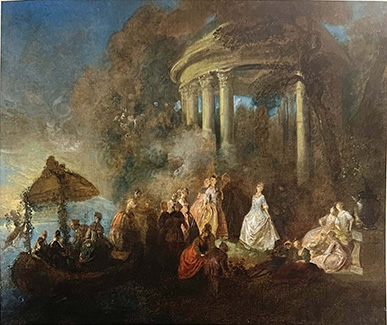 |
 |
| 6. Quillard, Arrival at Cythera, oil on canvas, 48 x 61 cm. New York, private collection. | 7. Quillard, Arrival at Cythera, oil on canvas, 26.9 x 32.1 cm. Glasgow, Kelvingrove Museum.
|
Indeed, the works are more than merely analogous; they are almost identical in composition, each to the other and to the Budapest painting. The compositions of all three are the same, with a boatload of pilgrims alighting on an island where other figures are assembled, some conversing but the majority watching a woman dancing. Behind them rises a tholos temple sheltering a cult statue of Venus. In comparing these three different versions of the one composition, one cannot fail to notice how many of the individual figures are repeated without change. A major difference among them is their scale, the Budapest version being much larger, the one in New York is slightly reduced in scale, while that in Glasgow is considerably smaller. The degree of finish also varies: the Budapest version is the most polished while the other two are rendered in a more summary manner.
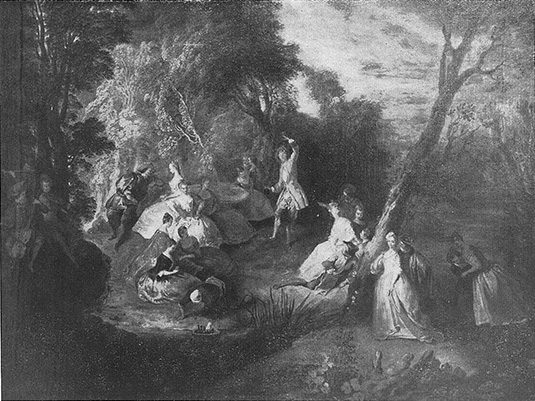 |
|
A third addition to Quillard’s oeuvre is a charming fête galante that came up at auction a half century ago (fig. 8), traveling under a mistaken attribution to François Octavien (1695-c. 1740), another of Watteau’s so-called satellites.5
 |
| 9. Pierre Antoine Quillard, The Happy Drinker, oil on copper, 43 x 53 cm. St. Petersburg, Hermitage Museum. |
Not only does it show every characteristic of Quillard’s art but also it is closely related to a Quillard fête galante in the Hermitage, the so-called Happy Drinker (fig. 9). Although the new painting is twice the size of the Russian picture, the artist has copied his composition with no major changes, and very few minor ones. Because the painting in St. Petersburg is well known, whereas the one sold in 1967 is new to us, it is tempting to identify the latter as a copy of the former, but in actuality we cannot be sure which has priority.
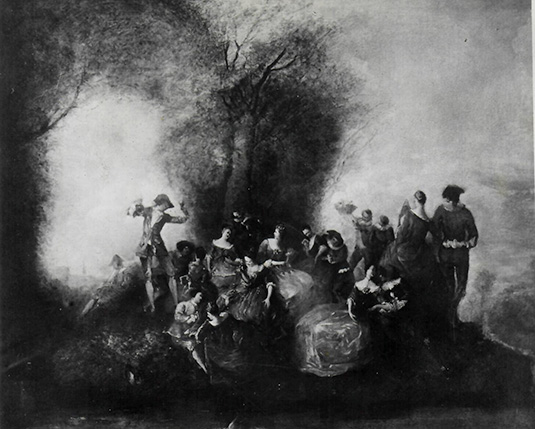 |
| 10. Pierre Antoine Quillard, Fête Galante on a Hillock, dimensions and location unknown. |
Closely related to the previous two paintings depicting the so-called “Happy Drinker” is a third picture that was on the Paris market many decades ago. The composition is typical of Quillard, especially the grouping of the figures on a hillock or island. At the left side is a man silhouetted against the sky, energetically raising a glass with one hand and a bottle with the other; the exuberance of his gesture and the effervescence of his pose evoke the figure of the Happy Drinker in the other two paintings, but he is not identical to them. The exaggerated turn of many of the heads and the awkward positioning of limbs strongly recall Quillard’s manner. This new work, which I know only from a fuzzy photograph, was attributed to the “School of Watteau” but that is a common defensive classification. A word of caution must be introduced, for although the picture has all the earmarks of a painting by Quillard, it seems to have greatly suffered from gross overpainting that obscures the original surface.
 |
| 11. Pierre Antoine Quillard, Peasant Family, oil on canvas, 21 x 43 cm. Whereabouts unknown. |
The fourth and fifth works introduced here each depict a peasant family. When a dark picture of this subject appeared at auction in 2007 (fig. 11), it too was attributed to the circle of Watteau, an unsatisfactory idea.6 There is no rationale to justify that attribution; neither its style nor its subject has any correlation with Watteau’s established oeuvre.7
 |
| 12. Pierre Antoine Quillard, Rustic Family, oil on canvas. 38.5 x 50 cm. Whereabouts unknown. |
Quillard, however, is a suitable candidate. Far from recalling Watteau or his close imitators such as Pater or Lancret, this Rustic Family is identical to a Quillard composition from the later part of his career when he worked in Portugal (fig. 12), one of several pictures that until recently remained there in the collection of the Cadaval family, important patrons of his.8 The artist depicted not only the same figures as in the Cadaval composition but also the arrangement of the trees. But which version had priority? Save for the new version being smaller and having a rectangular format (unlike the oval of the ex-Cadaval painting), little else differentiates them.
 |
| 13. Pierre Antoine Quillard, Concert champêtre, oil on canvas, 90 x 120 cm. Formerly Lyon private collection. |
A sixth painting to be added to Quillard’s oeuvre is one also known only through a small photograph in the Service de documentation of the Musée du Louvre (fig. 13). Like so many authorless fêtes galantes, it was ascribed to Watteau in the early twentieth century, and was published (but not illustrated) in the 1920s with an attribution to the master.9 In the 1940s it was assigned to Nicolas Lancret by a local Lyon appraiser, and this information was repeated by Adhémar and others, though without creditable documentation. Indeed, the painting has nothing in common with Watteau’s or Lancret’s figural style nor with their compositional preferences. Instead, it is directly related to Quillard. The figure types with small heads and elongated necks, especially the women in the left foreground, wholly accord with Quillard’s manner.
 |
| 14. Pierre Antoine Quillard, Amusements champêtres, etching. |
Most conclusively, the painting is closely related to an etching that Quillard executed with the caption, Amusements champêtres (fig. 14).10 Although the artist is not designated on the etching, it is now generally agreed that the print was executed by Quillard. The painted and etched compositions are quite similar; the figures in the right halves of the Lyon painting and the etching are identical, but the left sides differ. As will be demonstrated apropos of the Quillard painting in Philadelphia (fig. 15), the artist occasionally repeated himself in just this manner, duplicating one half and introducing variations in the other half. This was Quillard’s modus operandi.11 The correspondence between the Lyon painting and the etching raises the question of which version inspired the other. In truth, we cannot be sure which had priority.
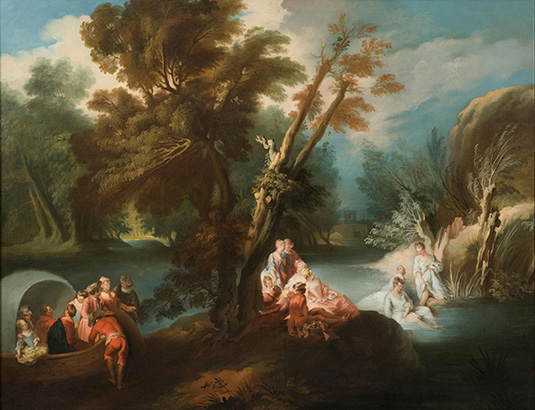 |
| 15. Pierre Antoine Quillard, A Fête Galante with Bathers, oil on canvas, 121 x 147.3 cm. Philadelphia Museum of Art. |
The Philadelphia Museum of Art boasts a strikingly handsome but unpublished picture by Quillard. In 1980, when this work came up at auction in Paris, it was attributed to François Octavien (1695-1736), one of Watteau’s lesser satellites.12 One might wonder if it was not previously attributed to Watteau himself or to Pater or Lancret, the latter two artists having produced a large number of pictures showing women bathing in a stream (fig. 24). The picture then was owned by the Sabin Galleries of London, who probably recognized Quillard’s authorship.13 The work was sold in 1985 to Drs. Peter and Caroline Koblentzer of Philadelphia, and they subsequently donated it to the museum.
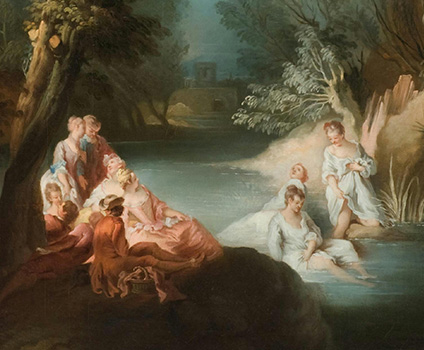 |
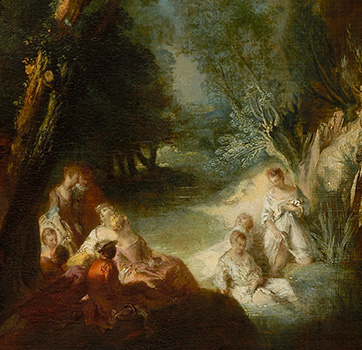 |
16. Pierre Antoine Quillard, A Fête Galante with Bathers (detail). Philadelphia Museum of Art. |
17. Pierre Antoine Quillard, A Fête Galante with Bathers (detail). Antwerp, Ridder Smidt van Gelder Museum. |
Again, the attribution of this seventh painting to Quillard is reinforced by its close relationship to other works by the artist. Above all, the right side of the Philadelphia composition is essentially the same as the Quillard painting in the Ridder Smidt van Gelder Museum (figs. 16, 17). In the nineteenth century the Antwerp painting was in the collection of the Empress Eugènie, masquerading as a work by Pater.14 The elegantly dressed people entering the bathing area echo those in the Antwerp painting, and the bathers are quite similar, though not identical, to those in Antwerp. As seen, it was Quillard’s habit to repeat a whole section of one of his paintings to create a new composition. In this instance we cannot be certain which painting copies the other. The Antwerp picture could have been the source for the right-hand portion of the Philadelphia picture, or the Philadelphia composition could have been the source for the right side of the Antwerp canvas. Without a fixed chronology for Quillard's works, we cannot draw any conclusion regarding the direction that the idea flowed.
Yet another paintings can be added to Quillard’s oeuvre, a rustic scene of people dining outside a country inn (fig. 18). They are serenaded by a strolling vielle player and a boy with a tambourine. When it appeared at auction in 1996 and again in 2006, the picture was first attributed to Philippe Mercier (1689-1760), one more Watteau satellite to whom a great many authorless paintings are given, and then it was ascribed to a follower of Mercier.15 Yet it is evident that the painting is not by Mercier or any putative follower. Rather, the general aspect of the composition and the features of the man and woman at the table typify Quillard’s work. Also the general composition is comparable to some of his other paintings, especially Repast Beneath an Arbor (fig. 19) and the Allegory of Autumn, one of Four Seasons now in the Thyssen-Bornemisza Collection (fig. 20).
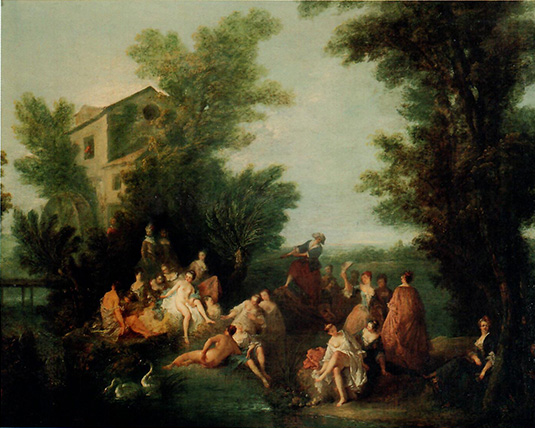 |
| 21. Pierre Antoine Quillard, Scene with Bathing Women, oil on canvas, 69.8 x 86.4 cm. Whereabouts unknown. |
An ambitious scene of bathing women that came on the New York market more than two decades ago should also be attributed to Quillard (fig. 21).16 When this unpublished work appeared at auction in 1998, it was attributed to Bonaventure de Bar (1700-1729). One can only wonder why it was given to this minor satellite of Watteau. There are no comparable scenes of bathing women in de Bar’s oeuvre, an oeuvre that is quite small because the artist died so young. And although de Bar painted a number of ambitious works populated with many diminutive figures, his figure types are quite different.17
On the other hand, the figures in the Scene with Bathing Women—with their tiny heads and mannered,
elongated proportions—correspond to those in established Quillard paintings. The grouping of the people in
clusters on discontinuous islands accords with the way thar Quillard frequently structured his
paintings, such as The Happy Drinker (figs. 8,9).
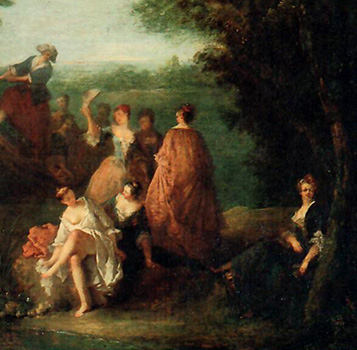 |
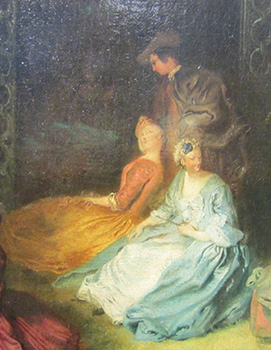 |
22. Pierre Antoine Quillard, Scene with Bathing Women (detail). |
23. Pierre Antoine Quillard, The Flute Player (detail). Florence, Uffizi. |
The woman standing to the right of center, holding a fan aloft to shade her face, assumes
the type of twisted, contrapposto pose that Quillard favored. The way that her head is bent back, the
underside of her chin exposed, could be considered Quillard’s hallmark and is seen in so many of his paintings, such as the Flute Player in the Uffizi (fig. 23).
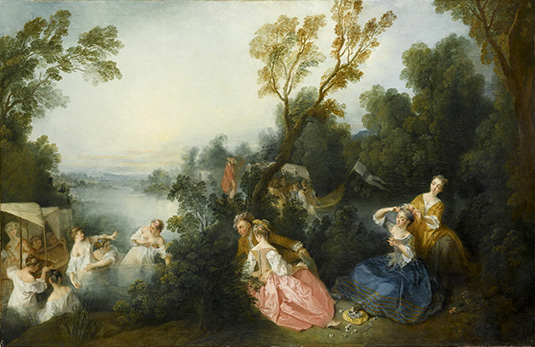 |
| 24. Nicolas Lancret, The Pleasures of Summer, oil on canvas, 97.2 x 1.458 cm. Paris, Musée du Louvre. |
Quillard’s portrayal of bathing women has much in common with paintings of this subject by Watteau’s other satellites more so than with Watteau. The oval painting at the center of L’Enseigne de Gersaint, Watteau’s one notable attempt at such a subject, shows the women striking essentially traditional poses, and they are nude rather than undressed. By contrast, Quillard’s women are either partially or wholly undressed, and the fully dressed men and women who spy on this secluded glen are reminders that the scene is set in the contemporary world, not in a timeless Arcadian past. Many of the features in Quillard’s rendering correspond to what Lancret and Pater portrayed in such scenes of bathing (fig. 24), but which way did the influence flow? Was Quillard influenced by them or vice versa? Quillard’s relationship to his contemporaries remains to be explored.
25. Pierre Antoine Quillard, The Foursome, oil on canvas, 108 x 86 cm. Whereabouts unknown. |
The Foursome, a painting that came up for sale in 1974 and again in 2001, is a tenth addition to Quillard’s oeuvre (fig. 25). At its first appearance it was classified just as an eighteenth-century French work, and the second time it was attributed to Lancret.18 Neither ascription was on target, since the picture has all the hallmarks of being by Quillard. The large scale of the figures and the relative simplicity of the composition align it with a number of other compositions he painted in the latter part of his career, perhaps while still in France or in Portugal. Repast Outside a Country Inn (fig. 18), for example, offers strong analogies in terms of its compositional structure.
 |
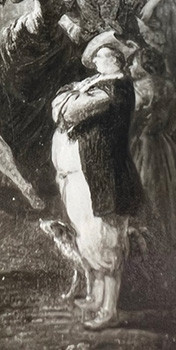 |
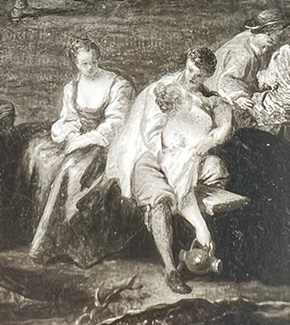 |
26. Pierre Antoine Quillard, The Foursome (detail). |
27. Pierre Antoine Quillard, Village Fête (detail). Whereabouts unknown. |
28. Pierre Antoine Quillard, Village Fête (detail). Whereabouts unknown. |
As so often occurs in Quillard’s oeuvre, figures in The Foursome correspond to ones in his other paintings. The portly man standing at the right side has a counterpart in a figure at the right side of Quillard’s Village Fête (fig. 27).19 Their poses are the same: lowered heads, crossed arms, feet splayed. Even the way the two men’s hat are pulled down at a rakish angle, accentuating the silhouetted profiles of their faces. Moreover, both paintings share in common a woman seated to the left, her hands in her lap, her scooped bodice, her head turned slightly to the side (fig. 28). These correspondences help substantiate the attribution of both paintings to Quillard and reinforce our sense of how Quillard frequently repeated himself.
 |
29. Pierre Antoine Quillard, Fête Galante with a Woman on a Swing, oil on canvas, 37.4 x 58.2 cm. Whereabouts unknown. |
The eleventh painting that can be given to Quillard is a fête galante with a woman on a swing, and several others relaxing on the ground (fig. 29). When it appeared on the market it was assigned to Michel Bartélemy Ollivier (1712-1784).20
30. Pierre Antoine Quilllard, Fête champêtre, oil on canvas, 37.5 x 57.7 cm. Los Angeles, collection of Ariane and Lionel Sauvage. |
However, this painting’s composition and mood are closely allied with several other fêtes galantes from Quillard’s maturity, especially one in the Sauvage collection (fig. 30). The two works are so comparable in appearance and essentially identical in measurements that one could well conclude that they were originally pendants. Their gentle palette, their openness of structure, their sense of freshness and their reliance on just a few graceful figures are a welcome relief from the over-crowded compositions in many of his other works. Grace of movement and pastoral beauty dominate in these two paintings.
The eleven paintings introduced in this essay do not reveal unexpected stylistic features of Quillard’s oeuvre. Instead, they reinforce our existing sense of his art. They also underscore aspects of his shop practice, and how he often chose to produce copies or variations of already established compositions. With this new awareness of the artist’s tendency to repeat himself comes an intriguing question, namely how did he accomplish this? The groups of figures that he transposed from one picture to the next are too complex for him to have relied merely on his memory of previous pictures. Did he possibly work from older paintings that he kept in his studio and used for reference? Or did he make compositional drawings or oil counterproofs to guide him? It would seem that the more we know of Quillard, the more enigmatic he becomes.
NOTES
1 Cologne, Kunsthaus Lempertz, May 20, 2006, lot 1127: Circle of Jean-Baptiste Pater, Fröhliche Gesellschaft im Freien, bought in; Munich, Hampel, December 3, 2010, lot 292: Jean-Baptiste Pater, Gesellschaft im Freien.
2 For these paintings, see Martin Eidelberg, “Autour du nom de Quillard,” Bulletin de la Société de l’histoire de l’art français (1979), 133.
3 The painting came to the Budapest museum in 1957 as a bequest from Mrs. Jósef Csetényi. It was published by Andor Pigler, Katalog der Galerie Alte Meister (Budapest: 1967), 188, as a German work under the influence of the French school. By 1991, its attribution was changed to Quillard; see Agnes Szigethi in Vilmos Tátrai, ed., Museum of Fine Arts Budapest, Old Master Paintings, Summary Catalogue (Budapest: 1991), 144.
4 See Martin Eidelberg, “Autour du nom de Quillard,” 136-38. Also Valenciennes, Musée des beaux-arts, Watteau et la fête galante (Paris: 2004), cat. 20; Paris, Musée Jacquemart André, De Watteau à Fragonard: Les Fêtes galantes (Paris: 2014), cat. 15.
5 Versailles, Chevau-Légers Enchères, May 30, 1967, lot 61: François Octavien, Scène galante dans un parc.
6 Florence, sale, Pandolfini Casa d’Aste, March 27, 2007, lot 146: Circle of Jean Antoine Watteau, Paesaggio notturno. The picture did not sell.
7 A possible exception might be L’Occupation champêtre, a painting that was engraved under Watteau’s name c. 1730 by Pierre Rochefort. However, although that work has been ascribed to Watteau in the past, the stylistic evidence and Portuguese provenance suggest that it is actually by Quillard; see Martin Eidelberg, http://watteau-abecedario.org/X_Occupation champetre.htm.
8 The ex-Cadaval painting sold in New York, Sotheby’s, October 15, 1987, lot 159. Curiously, no provenance was listed for it.
9 The Lyon painting was given to Watteau by Raymond Messal; see his “Un Watteau inconnu,” Bulletin de la Société de l’histoire de l’art français (1926), 166-67; ibid. (1930), 219. A subsequent re-attribution to Lancret was proposed in an expertise prepared in Lyon by Edmond Delaye (1874-1964); the document does not disclose the name of the owner or the location of the painting but presumably it was in the Lyon area. The date in the last sentence is “8 décembre 19 . . . ” but the last digits have been effaced. The document was evidently created in the years before or after World War II. The account given by Hélène Adhémar, Watteau, sa vie—son oeuvre (Paris: 1950), under cat. 230, is confused.
10 For this etching, see Emile Dacier, Albert Vuaflart, and Jacques Hérold, Jean de Jullienne et les graveurs de Watteau au XVIIIe siècle, 4 vols. (Paris: 1921-29), 3: cat. 315.
11 A painting identical to the etching appeared at an unidentified French auction under an attribution to the “école de Watteau” on June 29, 1951. However, the reproduction is insufficiently clear to judge whether it is by Quillard or is just an anonymous copy after the print.
12 Paris, sale, Hôtel Drouot, June 18, 1980, unnumbered lot. Curiously, the sale catalogue measured the picture at 87 x 1.15 cm, i.e., a substantially smaller size than the painting now in Philadelphia. However that catalogue seems not to have been prepared carefully.
13 The Sabin Gallery also once owned the Quillard now in the Ritter Smidt van Gelder Museum. Although they bought the Fête Galante with Bathers, as a work by Pater, they were aware of the later reattribution to Quillard.
14 For the painting in Antwerp, see Frank van den Wijngaert, Het Museum Smidt van Gelder (Deurne: 1951), 8, where the painting is still given to Pater. As I have shown, not only is it recognizably by Quillard, but its provenance and authorship can be traced to the eighteenth century; see Eidelberg, ”Autour de nom de Quillard,” 131-33.
15 London, sale, Sotheby’s, April 13, 1996, lot 131: Philippe Mercier, Visit of the Minstrel; London, Christie’s South Kensington, December 6, 2006, lot 133: follower of Philippe Mercier, Minstrels Performing for a Couple at a Table Outside an Inn.
16 The painting had previously been in the collections of Broussard de la Barre, Paris; Count Armand de Marcy; and Audrey Maynard Auchincloss, Washington, DC. It was sold from the latter collection in New York, Sotheby’s, May 21, 1998, lot 138.
17 For de Bar’s paintings, see Eidelberg, “Defining the Oeuvre of Bonaventure de Bar” (June 2011), http://watteauandhiscircle.org/de%20bar%201.htm.
18 It appeared at auction in Milan, Finarte, May 16, 1974, lot 125. Then it was offered for sale at Cologne, Kunsthaus am Museum, September 2001.
19 The Village Fête appeared at an auction in Paris, Hôtel Drouot, June 17-18, 1936, lot 167. It was bought by Jean Cailleux who recognized that this picture, which had presented as an anonymous work, was by Quillard. It was exhibited at the Galerie Bernheim-Jeune, La Douceur de vivre (1948), cat. 24, and was published by Michel Florisoone, Le Dix-huitième siècle (Paris: 1948), pl. 41.